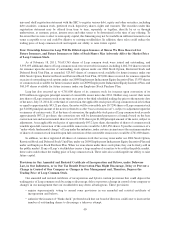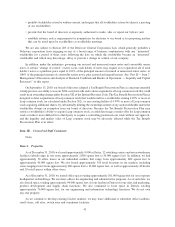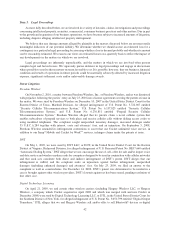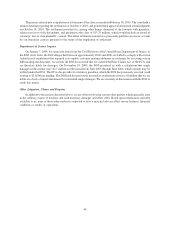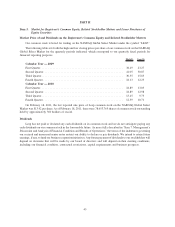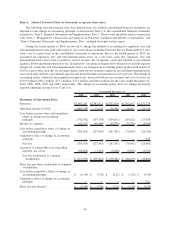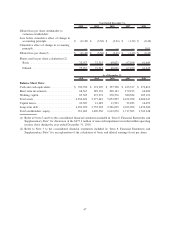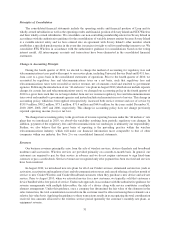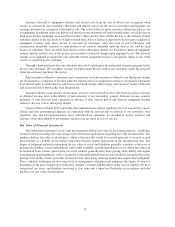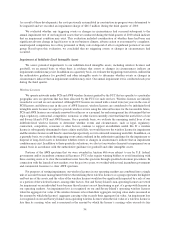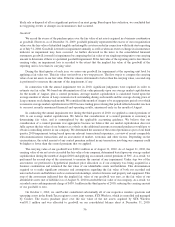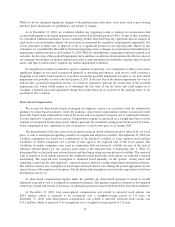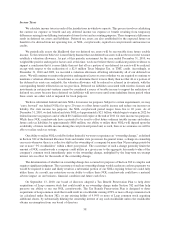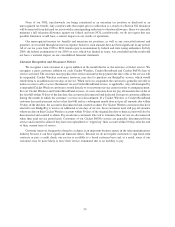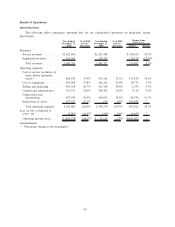Cricket Wireless 2010 Annual Report Download - page 56
Download and view the complete annual report
Please find page 56 of the 2010 Cricket Wireless annual report below. You can navigate through the pages in the report by either clicking on the pages listed below, or by using the keyword search tool below to find specific information within the annual report.activated Cricket device not currently in service. Customers accepting this offer receive a free first month of service
on the additional line of service after paying an activation fee. We believe that this kind of program and other
promotions provide important long-term benefits to us by extending the period of time over which customers use
our wireless services.
The wireless telecommunications industry is very competitive. In general, we compete with national facilities-
based wireless providers and their prepaid affiliates or brands, local and regional carriers, non-facilities-based
mobile virtual network operators, or MVNOs, voice-over-internet-protocol service providers, traditional landline
service providers, cable companies and mobile satellite service providers. The competitive pressures of the wireless
telecommunications industry have continued to increase and have caused a number of our competitors to offer
competitively priced unlimited prepaid and postpaid service offerings. These service offerings present additional
strong competition in markets in which our offerings overlap, and the evolving competitive landscape has
negatively impacted our financial and operating results since early 2009. Our ability to remain competitive
will depend, in part, on our ability to anticipate and respond to various competitive factors and to keep our costs low.
In the August 2009 and March 2010, we revised a number of our Cricket Wireless service plans to provide
additional features previously only available in our higher-priced plans, to eliminate certain fees we previously
charged customers who changed their service plans and to include unlimited nationwide roaming and international
long distance services. These changes, which were made in response to the competitive and economic environment,
resulted in lower average monthly revenue per customer and increased costs. In August 2010 we introduced a
number of new initiatives to respond to the evolving competitive landscape, including revising the features of a
number of our Cricket service offerings, offering “all-inclusive” service plans, eliminating certain late fees we
previously charged to customers who reinstated their service after having failed to pay their monthly bill on time,
entering into a new wholesale agreement and nationwide data roaming agreement and introducing “smartphones”
and other new handsets and devices. We believe that these new initiatives will be attractive to customers, will help
improve our competitive positioning in the marketplace and will lead to improved financial and operational
performance over the longer term. Since their introduction, these August 2010 initiatives have led to higher average
monthly revenue per customer and lower customer turnover, although they have also resulted in increased costs,
including equipment subsidy for new and upgrading customers, sales and marketing expenses and other costs. The
extent to which our new initiatives will be successful and impact our future financial and operating results will
depend upon customer acceptance of our new product and service offerings.
Our principal sources of liquidity are our existing unrestricted cash, cash equivalents and short-term
investments and cash generated from operations. From time to time, we may also generate additional liquidity
by selling certain non-core assets or through future capital markets transactions. See “— Liquidity and Capital
Resources” below.
Critical Accounting Policies and Estimates
Our discussion and analysis of our results of operations and liquidity and capital resources are based on our
consolidated financial statements which have been prepared in accordance with accounting principles generally
accepted in the United States of America, or GAAP. These principles require us to make estimates and judgments
that affect our reported amounts of assets and liabilities, our disclosure of contingent assets and liabilities and our
reported amounts of revenues and expenses. On an ongoing basis, we evaluate our estimates and judgments,
including those related to revenue recognition and the valuation of deferred tax assets, long-lived assets and
indefinite-lived intangible assets. We base our estimates on historical and anticipated results and trends and on
various other assumptions that we believe are reasonable under the circumstances, including assumptions as to
future events. These estimates form the basis for making judgments about the carrying values of assets and
liabilities that are not readily apparent from other sources. By their nature, estimates are subject to an inherent
degree of uncertainty. Actual results may differ from our estimates.
We believe that the following critical accounting policies and estimates involve a higher degree of judgment or
complexity than others used in the preparation of our consolidated financial statements.
50


